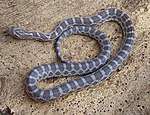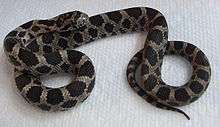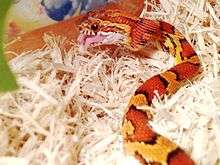Pantherophis
Pantherophis is a genus of nonvenomous colubrid snakes endemic to North America and Central America, commonly called rat snakes, fox snakes, and corn snakes. All are powerful constrictors and help control rodent populations. Some taxonomic classification systems have accepted the proposed classification, while others have not.
| Pantherophis | |
|---|---|
 | |
| Pantherophis guttatus | |
| Scientific classification | |
| Kingdom: | Animalia |
| Phylum: | Chordata |
| Class: | Reptilia |
| Order: | Squamata |
| Suborder: | Serpentes |
| Family: | Colubridae |
| Tribe: | Lampropeltini |
| Genus: | Pantherophis Fitzinger, 1843[1] |
| Synonyms | |
| |
Although Pantherophis was originally proposed in 1843, in more recent history, these species were placed in the genus Elaphe. In 2002, Utiger et al. raised a taxonomic suggestion to resurrect the genus Pantherophis based on mitochondrial DNA evidence suggesting the New World rat snakes are more closely related to king snakes than to the Old World rat snakes.[2] This was confirmed by later phylogenetic studies.[3]
However, the International Commission on Zoological Nomenclature rejected the renaming, thus Elaphe remains the more widely recognized and broadly accepted genus name. The ITIS now identifies all species names that use Pantherophis as "valid" names – no longer using Elaphe.[4]
Species
These species are included:[1][5]
| Image | Scientific name | Common name | Geographic range |
|---|---|---|---|
| Pantherophis alleghaniensis (Holbrook, 1836) | Eastern rat snake | United States east of the Apalachicola River in Florida, east of the Chattahoochee River in Georgia, east of the Appalachian Mountains, north to southeastern New York and western Vermont, eastern Pennsylvania, Maryland, South Carolina, North Carolina, Georgia, south to the Florida Keys | |
 | Pantherophis bairdi (Yarrow, 1880) | Baird's rat snake | Southwestern United States and adjacent northeastern Mexico. |
 | Pantherophis emoryi (Baird & Girard, 1853) | Great Plains rat snake | United States, from Missouri to Nebraska, to Colorado, south to Texas, and into northern Mexico |
 | Pantherophis gloydi (Conant, 1940) | Eastern fox snake | Eastern Great Lakes region of the United States, as well as adjacent western Ontario in Canada. |
 | Pantherophis guttatus (Linnaeus, 1766) | Corn snake | Southeastern and central United States. |
| Pantherophis obsoletus (Say, 1823) | Western rat snake or Texas ratsnake | West of the Mississippi River, from eastern and southern Iowa southward through Missouri and Arkansas to western Louisiana, westward to eastern Texas, northward through Oklahoma and eastern Kansas to southeastern Nebraska. | |
| Pantherophis ramspotti Crother, White, Savage, Eckstut, Graham & Gardner, 2011 | Western fox snake | United States, west of the Mississippi River | |
| Pantherophis slowinskii (Burbrink, 2002) | Slowinski's corn snake | Louisiana, eastern Texas, and Arkansas | |
| Pantherophis spiloides (A.M.C. Duméril, Bibron & A.H.A. Duméril, 1854) | Gray rat snake or central rat snake | Eastern and Central United States, west of the Appalachian Mountains and east of the Mississippi River | |
 | Pantherophis vulpinus (Baird & Girard, 1853) | Eastern fox snake | Upper Midwestern United States, east of the Mississippi River |
Fitzinger designated P. guttatus as the type species for the genus Pantherophis.
Taxonomy
In recent years, some taxonomic controversy arose over the genus of North American rat snakes. Based on mitochondrial DNA, Utiger et al. (2002) showed North American rat snakes of the genus Elaphe, along with closely related genera such as Pituophis and Lampropeltis, form a monophyletic group separate from Old World members of the genus. They therefore suggested the resurrection of the available name Pantherophis Fitzinger for all North American taxa (north of Mexico).[6]
The reception to the proposed reclassification has been mixed. In 2008, the Society for the Study of Amphibians and Reptiles accepted the taxonomic change to Pantherophis.[1] NatureServe and GBIF[7] use Pantherophis names. ITIS also now identifies all species names that use Pantherophis as "valid" names.[4] CITES recognizes Elaphe and does not recognize Pantherophis.[8]
References
- Crother BI (chair) (2012). Scientific and Standard English Names of Amphibians and Reptiles of North America North of Mexico. 7th ed. SSAR Herpetological Circular 39. 84 pp. PDF at SSAR. Accessed 4 July 2011.
- Utiger, Urs; Notker Helfenberger; Beat Schätti; Catherine Schmidt; Markus Ruf; and Vincent Ziswile (2002). "Molecular Systematics and Phylogeny of Old and New World Ratsnakes ..." Russian Journal of Herpetology 9 (2): 105-124.
- Pyron RA, Burbrink FT (2009). "Neogene diversification and taxonomic stability in the snake tribe Lampropeltini (Serpentes: Colubridae)". Mol. Phylogenet. Evol. 52: 524-529.
- ITIS Search results for Pantherophis (accessed August 2015).
- Pantherophis. The Reptile Database. www.reptile-database.org.
- Scotophis obsoleta Archived 2009-04-14 at the Wayback Machine at The Center for North American Herpetology. Accessed 20 June 2008.
- GBIF Backbone Taxonomy Species List, GBIF (accessed August 2015).
- CITES Trade Database, CITES (accessed August 2015).
Further reading
- Fitzinger L (1843). Systema Reptilium, Fasciculus Primus, Amblyglossae. Vienna: Braumüller & Seidel. 106 pp. + indices. (Genus Pantherophis, p. 25.)
- Utiger U, Helfenberger N, Schätti B, Schmidt C, Ruf M, Ziswiler V (2002). "Molecular systematics and phylogeny of Old and New World ratsnakes, Elaphe Auct., and related genera (Reptilia, Squamata, Colubridae)". Russian Journal of Herpetology 9 (2): 105-124.
External links
| Wikimedia Commons has media related to Pantherophis. |
- Pantherophis, SSARHerps
- Pantherophis, The Reptile Database